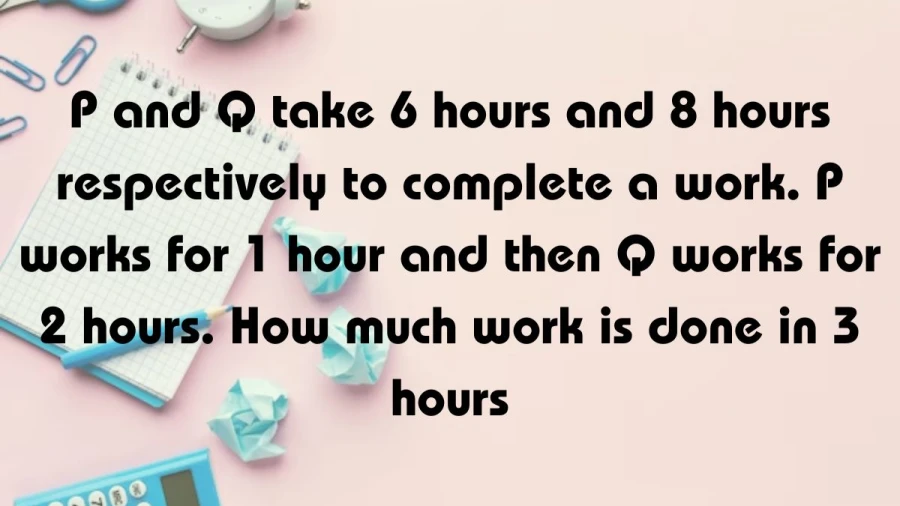If you happen to be viewing the article P and Q take 6 hours and 8 hours respectively to complete a work. P works for 1 hour and then Q works for 2 hours. How much work is done in 3 hours? ? on the website Math Hello Kitty, there are a couple of convenient ways for you to navigate through the content. You have the option to simply scroll down and leisurely read each section at your own pace. Alternatively, if you’re in a rush or looking for specific information, you can swiftly click on the table of contents provided. This will instantly direct you to the exact section that contains the information you need most urgently.
See how much work P and Q can do in 3 hours! P works for an hour, and then Q works for 2. Find out their combined progress in this quick read.
P and Q take 6 hours and 8 hours respectively to complete a work. P works for 1 hour and then Q works for 2 hours. How much work is done in 3 hours?
5/12 of the work is done in 3 hours.
To solve this problem, we need to first find the rates at which P and Q work per hour.
If P takes 6 hours to complete the work, then its rate is 1/6 of the work per hour. Similarly, if Q takes 8 hours to complete the work, then its rate is 1/8 of the work per hour.
Now, if P works for 1 hour, it completes 1/6 of the work. Then, if Q works for 2 hours, it completes 2×1/8=1/4 of the work.
So, in total, in 3 hours, they complete 1/6 + 1/4 = 2/12 + 3/12 = 5/12 of the work.
Therefore, in 3 hours, 5/12 of the work is done.
Work and Time Problems in Mathematics
Work and time problems are a common type of mathematical problem that involve calculating the amount of work done by one or more persons or entities working together or individually within a certain time frame. These problems often involve variables such as the rate at which work is done, the time taken to complete the work, and the total amount of work to be done.
Here’s a general approach to solving work and time problems:
-
Identify the given information: Understand what information is provided in the problem. This typically includes the total amount of work to be done, the rate at which work is being done, and the time taken to complete the work.
-
Determine the unknown: Determine what exactly the problem is asking you to find. This could be the time it takes to complete the work, the rate at which work is being done, or the total amount of work done.
-
Choose an appropriate formula or method: There are several formulas and methods that can be used to solve work and time problems, depending on the specific scenario presented in the problem. Some common methods include using proportions, setting up equations based on rates of work, or using the concept of efficiency.
-
Set up equations: Based on the given information and the unknown quantity you’re trying to find, set up one or more equations to represent the relationship between the variables involved.
-
Solve the equations: Use algebraic techniques to solve the equations and find the value of the unknown quantity.
-
Check your answer: Once you’ve found a solution, double-check your work to ensure that it makes sense in the context of the problem. Does the answer seem reasonable based on the given information?
Here are some common types of work and time problems:
-
Single person working at a constant rate: In this type of problem, you’re given the rate at which a single person can complete a certain task, and you need to find the time it takes for that person to complete the task alone.
-
Multiple people working together: This type of problem involves multiple people working together to complete a task. You’re given the rates at which each person can complete the task individually, and you need to find the time it takes for them to complete the task when working together.
-
People working at different rates: Sometimes, people working together may have different rates at which they can complete the task. In these problems, you need to consider the individual rates of each person and determine how long it takes for them to complete the task together.
-
Work done by machines: Work and time problems can also involve machines working together to complete a task. You may be given information about the efficiency or rate of each machine, and you need to calculate the time it takes for them to complete the task together.
Remember to carefully read the problem, identify the given information and what you’re being asked to find, and choose an appropriate method to solve the problem. With practice, you’ll become more comfortable with solving work and time problems in mathematics.
Thank you so much for taking the time to read the article titled P and Q take 6 hours and 8 hours respectively to complete a work. P works for 1 hour and then Q works for 2 hours. How much work is done in 3 hours? written by Math Hello Kitty. Your support means a lot to us! We are glad that you found this article useful. If you have any feedback or thoughts, we would love to hear from you. Don’t forget to leave a comment and review on our website to help introduce it to others. Once again, we sincerely appreciate your support and thank you for being a valued reader!
Source: Math Hello Kitty
Categories: Math

